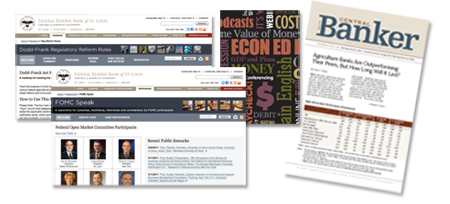Questions about the Budget Deficit of the U.S. Have No Easy Answers
|
The St. Louis Fed's new discussion series for the public, "Dialogue with the Fed: Beyond Today's Financial Headlines," is under way. Economists and others from the Bank talk about pressing issues related to the economy, after which the audience asks questions. William R. Emmons, an economist in the Banking Supervision and Regulation division, will be the featured speaker Oct. 18, 2011. His talk will be titled "What's Driving the Federal Budget Deficit, and What Can We Do About It?" What follows is a preview of his talk, based on questions he often receives. |
Q. Do we really have a problem with our federal budget, or has this been blown out of proportion?
A. We really do have a problem—in both the short-term and long-term. The reasons behind the former are, of course, the recent recession and financial crisis; their severity led to a huge expansion of the deficit. It would have been virtually impossible to prevent this large increase in the deficit after such an economic and financial shock. That's because our laws include many provisions that operate automatically ("automatic stabilizers") with no input from Congress or the president unless they choose to revise those laws—which they would be loath to do during a recession. Examples of spending categories that increase automatically when the economy slows include unemployment insurance and income-based benefits for health care and food. On the other side of the ledger, tax payments by individuals and businesses go down when their incomes fall.
Q. How much are we talking about?
A. Automatic stabilizers were $34 billion (7 percent of the deficit) during fiscal year 2008, $312 billion (22 percent of the deficit) during 2009 and $359 billion (28 percent of the deficit) during 2010. (The total deficits for these years were $459 billion, $1.413 trillion, and $1.294 trillion, respectively; the Congressional Budget Office [CBO] expects the 2011 deficit to come in at about $1.284 trillion.) These amounts will taper off if and when the economy picks up steam.
Q. But that still leaves about three quarters of the 2009 and 2010 deficits that weren't automatic. What else was going on?
A. Congress and the president agreed to significant increases in federal spending and decreases in tax revenues intended to cushion the blow of the severe recession and prevent the economy from sliding into a repeat of the Great Depression. These included increased infrastructure spending, substantial assistance for state and local governments, and purchases of financial assets and entire financial institutions—for example, Fannie Mae and Freddie Mac. Some types of taxes were decreased, and the large tax cuts of President Bush's era that were scheduled to expire at the end of 2010 were extended.
Q. Help me with the math—how much do these discretionary deficits amount to?
A. The discretionary components of the federal budget deficit during fiscal years 2008, 2009 and 2010 were $425 billion, $1.1 trillion and $935 billion, respectively.
Q. And what is driving the long-term federal budget problem?
A. Two main factors, according to the CBO: an aging population and the rapid increase in spending on health care. (See related article in this issue.)
Q. Which budget problem is more serious—the short-term or the long-term?
A. The long-term. In the short term, renewed economic growth and a few budget adjustments would bring the deficit back down to a reasonable level. Investors both at home and abroad show limited concern about short-run deficits.
On the other hand, we know the long-term problem is being taken more seriously by investors because, in part, Standard & Poor's downgraded the Treasury's long-term debt recently. And financial history is full of countries that let their deficits run out of control to the point that the interest on the debt itself starts to compound at a frightening pace. At some point, these countries cannot raise enough tax revenue or borrow from investors, and they default.
Q. Couldn't the government refinance its debt at low interest rates for the long haul, just as an individual combines his credit-card and other debts and takes out a home equity loan at a fixed low rate for 30 years?
A. The Treasury could, in principle, borrow a lot more at very long maturities to lock in current rates. It is unlikely to do that. Among the reasons:
- The Treasury's debt-management strategy targets an average maturity of closer to five or six years. This lowers the short-term cost of borrowing (shorter maturities are cheaper to issue) and conforms to long-standing practice and market expectations. The Treasury believes that it can minimize its borrowing costs over time by maintaining deep and liquid markets all along the Treasury yield curve, from a few days out to 30 years. As for going further out—50 or 100 years, for example—I don't think such a move would conform to the Treasury's strategy. It would also be difficult to maintain liquid markets at maturities that extend that far into the future.
- There is no guarantee that current long-term rates would be favorable for the Treasury. Long-term rates could go lower—look at Japan.
- Long-term rates are comparatively expensive today. The Treasury pays 3.5 percent to borrow at 30 years, but it pays essentially zero to borrow for a few months.
Q. What is the tipping point for the debt—the point where, as you say, deficits run out of control and interest on the debt starts to compound at a frightening pace?
A. No one really knows. Some well-known economists have been preaching that a debt-to-GDP ratio of 90 percent is the tipping point, based on their study of other countries' debt crises. Critics of these economists, however, say that this is a simplistic and naïve number based on countries that are not relevant for comparison to the U.S. As a counter-example, Japan has outstanding government debt of over 200 percent of GDP, and that country has had no trouble to date in borrowing at very low rates.
Another approach to this question is to look at the very long term—say, 50 or 100 years out or more—and define the determinants of a sustainable long-run debt roll-over strategy. Economists have done this and have concluded that a country with a primary budget balance of zero (the budget balance excluding interest payments) can roll over its debt indefinitely, however large it may be, as long as the average interest rate it pays is no higher than the growth rate of its potential revenue—essentially, the growth rate of the economy. Looking back, the U.S. has been in this position for significant parts of its history.
To be in this position again, we would need to bring our primary budget deficit down and hope that the economy continues to grow while investors continue to accept very low Treasury interest rates. Using fiscal year 2011 (Oct. 1, 2010-Sept. 30, 2011) as an example, the growth rate of nominal GDP was 3.7 percent (through the second quarter of 2011), and the average rate of interest paid on the outstanding debt was about 3 percent. Thus, if these rates persisted indefinitely, we could "afford" a primary deficit of about 0.7 percent of GDP each year and still roll over our debt successfully, even after making interest payments.
Unfortunately, our primary deficit during fiscal 2011 was about 7 percent of GDP—far too large to be covered by our modest financing advantage relative to GDP growth. The point remains, however, that it is conceivable the U.S. could roll over a very large stock of outstanding debt forever under the right circumstances. In fact, the CBO projects that our primary deficit will be close to zero by fiscal year 2014 if current policies—including the expiration of all temporary tax cuts and other scheduled provisions—are carried out.
Q. These discussions always end up with the experts saying that the only solution is to trim Medicare/Social Security for baby boomers. Is that true?
A. Yes, unless we are willing to raise taxes a great deal, which would harm the economy. The aging population and federal spending on health care are the two issues the CBO highlights in its long-term budget outlook. The way the CBO explains it, the aging of the population creates big budget pressures for a few decades, but then it recedes a bit. The aging of the population goes beyond the baby-boom generation, however, because even after all baby boomers have died, demographers expect the remaining population structure to be permanently older on average. That's because people will keep living longer, and the birth rate is flat or declining.
So, the aging population is a huge issue until about 2035; then, it becomes "just" a big issue.
Federal health-care expenditures, on the other hand, threaten to grow faster indefinitely than the economy and tax revenues unless we find a way to bring them under control.
|
Economic Information for All The Federal Reserve Bank of St. Louis provides a multitude of ways to learn about the economy and economics. There is something for every audience—researchers, teachers, business executives, students, bankers, community developers and the general public. We offer periodicals, online courses, videos, podcasts, workshops, web sites and, of course, data. To get started on using our free resources, go to www.stlouisfed.org |
 |
Views expressed in Regional Economist are not necessarily those of the St. Louis Fed or Federal Reserve System.
For the latest insights from our economists and other St. Louis Fed experts, visit On the Economy and subscribe.
Email Us






